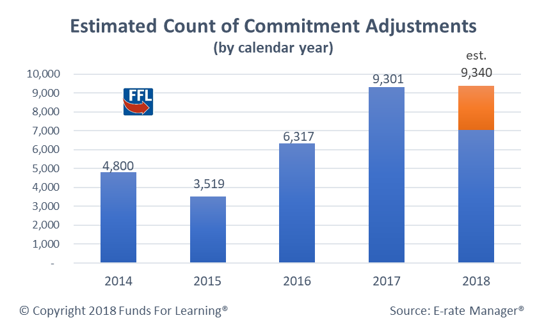Unfortunately, this is a scenario that is all too familiar to E-rate schools and libraries. Each week, I hear from applicants who have had reimbursements denied or been told that their funding commitments have changed. It is as if an army of acronyms have conspired against them: COMADs, RFCDLs, RIDFs, BNLs… and it all takes place with little or no explanation. It just happens. Of course, applicants can dispute USAC’s actions, but it is hard to know on what grounds to submit an appeal when there is no information to go on.
These hidden changes are happening more frequently. As previously noted, there has been a big jump in USAC requests for the return of funds. There has also been a dramatic increase in the overall number of changes to funding commitments. As illustrated below, in calendar year 2015, there were an estimated 3,519 funding commitments changed after they were awarded. By 2017, that number had skyrocketed to over 9,300, and 2018 appears to be on track for a similar pace.

It’s time now for the FCC and USAC to once again throw open the curtain and let light shine on the E-rate funding data. This time, we need to see what is being changed… and why? Whenever there is a denial, reduction, or adjustment to a form (of any kind), an applicant deserves to challenge USAC’s decision, and fairness dictates that they have the specific information necessary to make their claim.
Furthermore, the entire community needs to know what is taking place. As was noted back in 2002, E-rate funding decisions and payment paperwork exist in the public domain. USAC has a responsibility to keep the public informed of its actions with updated records whenever and wherever there are changes to funding decisions, payment paperwork, and other forms.
Schools and libraries benefit from a healthy E-rate program and one of the best methods of keeping the program strong is to keep E-rate funding decisions out in the open for all to see.
